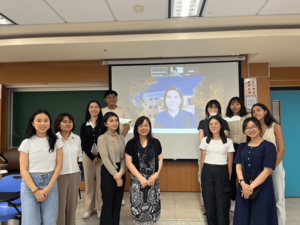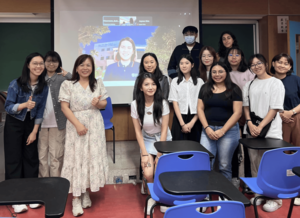A Journalism Expert from Nanyang Technological University Delivered Lectures Regarding News Consumption, Fake News, and News Media Literacy


Date :
2024-06-04
Department :
International Master's Program in International Communication Studies
【Article by IMICS】
Dr. Edson Tandoc, the President's Chair Professor of Communication Studies and the Associate Chair of Wee Kim Wee School of Communication and Information at Nanyang Technological University Singapore was invited by the New Media Convergence course’s instructor, Professor Trisha Lin, the Director of the Master’s Program in Global Communication and Innovative Technology (GCIT) to offer three-week sessions, starting on May 15. As a prominent scholar in the realm of fake news and a former journalist in the Philippines, Professor Tandoc shared invaluable insights on topics ranging from digital news consumption to fake news and news media literacy with NCCU students.
In the first class, Dr. Tandoc delved into the evolving landscape of the news ecosystem. He initiated the class by contemplating the meaning of the audience. He explored the origin of the term by touching on the different meanings of group, crowd, public, and mass audience. Dr. Tandoc highlighted two key factors driving the evolution: fragmentation and autonomy. Given the diverse backgrounds of the students, Dr. Tandoc asked, “How do you come across news in your home country?” Through active discussions, social media turned out to be the most frequently used media where students get news. Dr. Tandoc categorized their answers with four conceptual terms: routine surveillance, directed consumption, incidental consumption, and selective news consumption. Despite varied consumption patterns, Dr. Tandoc raised concerns about individuals who actively avoid news consumption.
Professor Tandoc’s second class covered fake news. He elucidated his research and shared survey findings on news consumption behaviors, highlighting intriguing findings. One survey uncovered the different levels of credibility of news articles based on situations. People reading news in a highly motivated situation processing information tended to believe news from official news media rather than from their friends. Conversely, in a low-motivated situation, the significant difference disappeared. Instead, people gravitated towards believing information shared by their friends. Moving on, Dr. Tandoc explained about fake news that is imitating the markers of real news. He delineated three dimensions—intention to deceive, low facticity, and news format—defining content that intersects these dimensions as fake news. Concluding the lecture, Dr. Tandoc stressed the importance of examining the broader contextual and cultural aspects beyond individual news consumers.
In the final lecture, Dr. Tandoc addressed how to combat fake news. He introduced several practical theories in journalism studies, including gatekeeping theory, nudging theory, and inoculation theory. Additionally, he showcased the Fake News Detective game, developed in NTU’s IN-cube, and its detailed design process. Students gained insights into applying inoculation theory and interventions. After elaborating on various types of literacy, he discussed students’ video assignments regarding young people’s digital news consumption. Amanda Li, a second-year student at GCIT, made an engaging video featuring adorable animals, conveying the message that “Even dogs and cats keep up with the news,” demonstrating innovative approaches to fostering news consumption. “I thought it would be boring if I convinced people to read the news. Instead, I chose cute animals that people are fond of.” Amanda explained. After appreciating classmates’ work, Dr. Tandoc ended the class by revisiting the concepts he touched on throughout the three weeks.
New Media Convergence is a course taught by Professor Trisha Lin to enhance students’ theoretical knowledge and practical skills in emerging media technology research. Supported by the Office of International Cooperation (OIC), Professor Lin has invited three co-instructors including Nanyang Technological University’s Professor Edson Tandoc, Stanford Social Media Lab’s Dr. Sunny Liu, and National University of Singapore’s Associate Professor Natalie Pang to share topics about how newly emerged technologies such as generative AI and deepfake impact audiences and industries.
Dr. Edson Tandoc, the President's Chair Professor of Communication Studies and the Associate Chair of Wee Kim Wee School of Communication and Information at Nanyang Technological University Singapore was invited by the New Media Convergence course’s instructor, Professor Trisha Lin, the Director of the Master’s Program in Global Communication and Innovative Technology (GCIT) to offer three-week sessions, starting on May 15. As a prominent scholar in the realm of fake news and a former journalist in the Philippines, Professor Tandoc shared invaluable insights on topics ranging from digital news consumption to fake news and news media literacy with NCCU students.
In the first class, Dr. Tandoc delved into the evolving landscape of the news ecosystem. He initiated the class by contemplating the meaning of the audience. He explored the origin of the term by touching on the different meanings of group, crowd, public, and mass audience. Dr. Tandoc highlighted two key factors driving the evolution: fragmentation and autonomy. Given the diverse backgrounds of the students, Dr. Tandoc asked, “How do you come across news in your home country?” Through active discussions, social media turned out to be the most frequently used media where students get news. Dr. Tandoc categorized their answers with four conceptual terms: routine surveillance, directed consumption, incidental consumption, and selective news consumption. Despite varied consumption patterns, Dr. Tandoc raised concerns about individuals who actively avoid news consumption.
Professor Tandoc’s second class covered fake news. He elucidated his research and shared survey findings on news consumption behaviors, highlighting intriguing findings. One survey uncovered the different levels of credibility of news articles based on situations. People reading news in a highly motivated situation processing information tended to believe news from official news media rather than from their friends. Conversely, in a low-motivated situation, the significant difference disappeared. Instead, people gravitated towards believing information shared by their friends. Moving on, Dr. Tandoc explained about fake news that is imitating the markers of real news. He delineated three dimensions—intention to deceive, low facticity, and news format—defining content that intersects these dimensions as fake news. Concluding the lecture, Dr. Tandoc stressed the importance of examining the broader contextual and cultural aspects beyond individual news consumers.
In the final lecture, Dr. Tandoc addressed how to combat fake news. He introduced several practical theories in journalism studies, including gatekeeping theory, nudging theory, and inoculation theory. Additionally, he showcased the Fake News Detective game, developed in NTU’s IN-cube, and its detailed design process. Students gained insights into applying inoculation theory and interventions. After elaborating on various types of literacy, he discussed students’ video assignments regarding young people’s digital news consumption. Amanda Li, a second-year student at GCIT, made an engaging video featuring adorable animals, conveying the message that “Even dogs and cats keep up with the news,” demonstrating innovative approaches to fostering news consumption. “I thought it would be boring if I convinced people to read the news. Instead, I chose cute animals that people are fond of.” Amanda explained. After appreciating classmates’ work, Dr. Tandoc ended the class by revisiting the concepts he touched on throughout the three weeks.
New Media Convergence is a course taught by Professor Trisha Lin to enhance students’ theoretical knowledge and practical skills in emerging media technology research. Supported by the Office of International Cooperation (OIC), Professor Lin has invited three co-instructors including Nanyang Technological University’s Professor Edson Tandoc, Stanford Social Media Lab’s Dr. Sunny Liu, and National University of Singapore’s Associate Professor Natalie Pang to share topics about how newly emerged technologies such as generative AI and deepfake impact audiences and industries.
